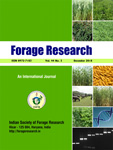AMARPREET KAUR*, POONAM KATARIA AND AVNEET KAUR
Punjab Agricultural University, Ludhiana-140 001 (Punjab), India
*(e-mail: 913amarpreet@gmail.com)
(Received : 7 September, 2024; Accepted : 26 September, 2024)
SUMMARY
This paper estimates the feed and fodder resources in Ludhiana district using primary data from 90 farmers spread over standard land holding categories. By referring to the standard values, i.e. a requirement of 4.02 kg of dry matter, most of the farmers of each farm size category attained the overall adequate status in the rainy season (83.3%), followed by the winter season (63.3%), and summer season (44.4%), which means that almost half of the sampled farmers (56% to be exact) had insufficient dry matter availability from green fodder during the summer season. The roughage to concentrate ratio observed for all the three seasons has been recorded as, summer (68.9:31.1), rainy (79.3:20.7) and winter (72.1: 27.9) against the standard normative requirement of 67:33. Overall 94.7 per cent of large, 88.5 per cent of medium and 73.1 per cent of the small farmers had adequate total dry matter intake on their farms. It can be concluded that Punjab state is lucky to have relatively enough dry matter availability on an overall basis, which may be related to a greater degree of awareness about the relevance of feed and fodder in enhancing livestock output. However, the nutritionally insufficient dry matter intake from green fodder during lean seasons in the majority of farms points to the need to sensitize farmers about better land resource management and appropriate fodder crop selection to provide year-round availability of green fodder.
Key words: Availability, adequacy, dry matter, green fodder, requirement

